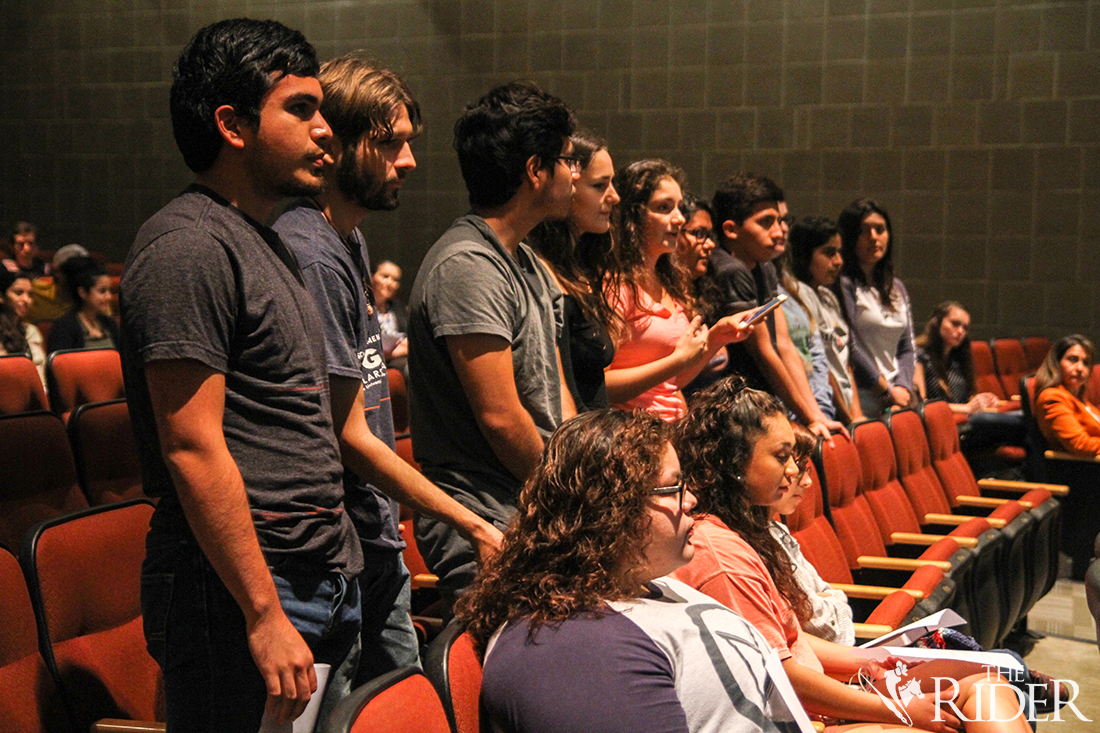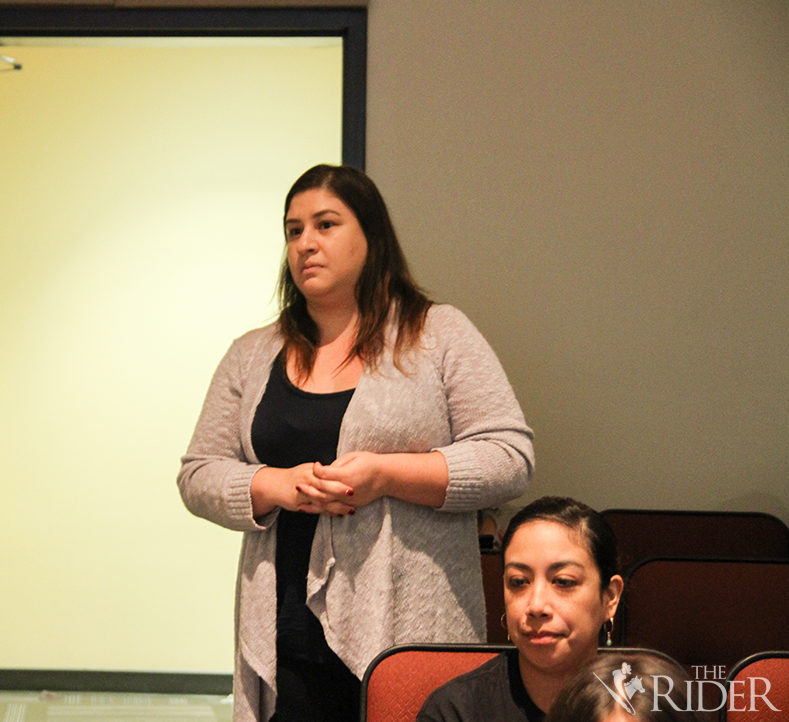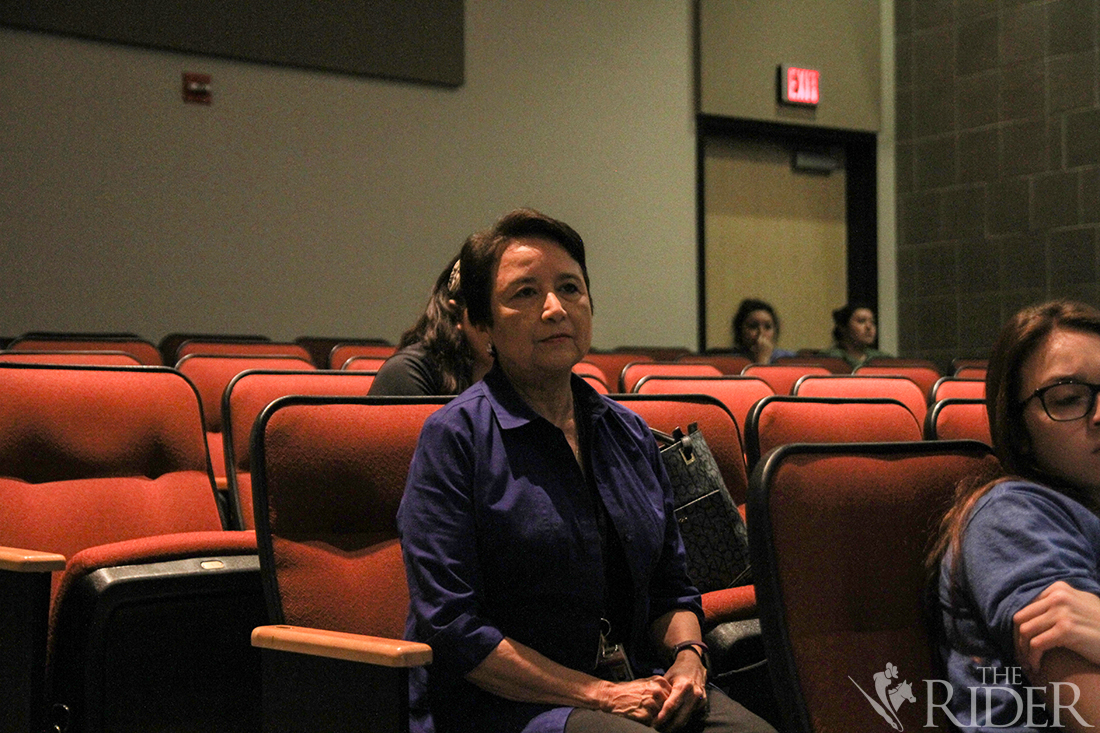
Members of the Environmental Awareness Club and Young Democratic Socialists of America inquire about the possibility of a green fund for UTRGV. SERGIO GARCIA/THE RIDER PHOTOS
In the second Tuition and Fee forum, held today on the Edinburg campus, students and faculty asked university officials why their proposal does not include a green fund and how increasing total academic cost will benefit the student body.
More than 70 campus community members attended the Tuition and Fee forum held in the Student Union Theater.
As previously reported by The Rider, the proposal recommends an athletics fee of $13.65 per credit hour capped at 12 credit hours; a transportation fee of $5 per credit hour capped at 12 credit hours; and a Student Services fee of $7 per credit hour capped at 12 credit hours.
During the Q&A session of the forum, about 20 members of the Environmental Awareness Club and Young Democratic Socialists of America stood up and asked when UTRGV will implement a green fund.
“There have been a number of different sustainability things on different campuses I’ve been on,” replied Rick Anderson, the UTRGV Finance and Administration executive vice president. “None of the campuses had a separate sustainability fee. … I’m not aware if the other 36 campuses if they even have a separate sustainability fee or not.”
Raziel Flores, a UTRGV biology graduate student, told Anderson the major University of Texas System campuses, including Austin, have a green fee.

“It might be something to look into,” Flores said. “I don’t know if the university is open to look into this, but it’s proven to bring success and, pretty much, we want the same success.”
Anderson responded by saying it is something the Tuition and Fee Steering Committee would need to seek input for and did not know if it is something it can move forward with in this cycle.
Flores asked what would be the next steps students can take. Anderson said providing input through the survey and the committee’s email would be the best thing to do.
Flores then asked if the survey would include questions related to his request. Vice President of Strategic Enrollment Maggie Hinojosa responded to Flores.
“Let me tell you what’s important,” Hinojosa said. “What’s important to know is what the money is needed for. So, when you get that survey, or even just email us, and let us know these are the types of things you would like to do with the potential fee, because it could be that we may be able to find other funds without having to assess a fee.”
Flores said he was surprised not many people had heard about a sustainability fee, in spite of being successful in other UT System schools.
“It’s not so much that we’re going to tax you for a fee,” he said. “[It’s] a fee that goes into sustainability. So, in the long run, it’s really more of an investment, not a fee.”
Alejandro Sanchez, a UTRGV Mexican American Studies graduate student, said he did not understand how the university did not include a sustainability fee option in its proposal.
“I think that if the university can go ahead and invest in athletics, it can go ahead and invest in more sustainable options,” Sanchez said. “Personally, I do not see a certain reason why something as simple as a green fund is not up there when most of UT [System schools] already [have] one.”
Earlier in the forum, a student asked if financial aid would increase if tuition is raised.
“When tuition increases, we have a certain amount of set-aside required by the state, by UT System,” Anderson replied. “I think it’s around 15 percent. … Any kind of tuition and fee increase, you will see there, by statute, at least 15 percent of it, that’s the minimum, will be set aside for, predominantly, need-based aid.”
Communication Associate Professor and Faculty Senate President Dora Saavedra asked Anderson if the committee had taken into consideration the challenges DREAMers face and how they could impact their four-year guaranteed rates.
Saavedra said some students have to take a semester off or work full time during the summer just to pay for one semester of classes, which does not allow them to graduate in four years.
“Let your students know that DREAMers do qualify for financial aid in certain perspectives,” Hinojosa told Saavedra. “There is something called the TAFSA, which is the state application for financial aid that any undocumented student can apply for. … One of the things that we have done to specifically address that, and this started several years ago, is with our tuition set-aside dollars, we have a program called UTRGV Achieve.”
Students who qualify for the program “have tuition and fee expenses and $500 of book expenses per semester for the regular academic year (fall and spring) covered by grant and/or scholarship aid,” according to the UTRGV website.
A student, who said she was a recipient of the UTRGV Achieve program, asked Hinojosa if increasing tuition and fees will help provide availability for DREAMers to work on campus so they do not have to take a semester off to pay for classes.

“We know that work is problematic for our DREAMers and that we have to follow the regulations, but … UTRGV Achieve is not the only grant that our DREAMers are eligible for,” Hinojosa replied. “There are other state grants as well. We do everything we can in Financial Aid to package what we can with the money that we have.”
Several students asked what benefits come from paying a student services fee and how much money will be allocated to different programs, including fine arts.
Anderson said he could not predict the specific amount that would go into a college, school or program. Hinojosa told attendees the Student Fee Advisory Committee is in charge of providing recommendations to UTRGV President Guy Bailey on how student services fee revenue should be distributed.
Isaac Martinez, a chemistry junior, asked the committee why the university did not have a recycling program implemented.
Anderson said it is difficult to implement a program when Edinburg and Brownsville do not have citywide recycling ordinances.
Hinojosa told Martinez she encourages him to request funding from the Student Fee Advisory Committee.
At the end of the forum, UTRGV History Lecturer Mayra Avila asked the committee how many students actually graduate in four years.
The audience responded with a hearty applause.
“Most of the students finish in five to six years because of the classes being taken, and you’re telling them this is not going to affect them when it is, because, most will not finish in four years,” Avila said.
Avila asked the students in attendance how many of them take 15 hours of classes. Only about eight students raised their hands.
“When we started UTRGV, 24 percent of our students were taking 15 hours,” Hinojosa said. “We are now at 35.5 percent.”
After her response, at 1:15 p.m., Anderson and Hinojosa ended the forum, despite several students having their hands raised for questions.
The forum was scheduled from 12:15 to 1:30 p.m., as advertised on posters placed throughout campus, email and social media.
The Rider asked Anderson why the forum ended early.
He replied: “I thought it was scheduled for an hour, so that’s kind of why I kept to that. Plus, we had pizza waiting for the students.”
The Rider asked Avila if she was satisfied with the responses provided during the forum.
“No, I am not,” she said. “I don’t feel like they answered the questions properly, because I asked for a percentage [of the four-year graduation rate] and they never gave me a percentage. Yeah, most students are taking 15 units because they’re paying the same costs, but how many can actually afford a summer class? It’s $1,000. Can you really afford to take [classes] every single summer? No. A lot of them are working and a lot of them have to pay out of their own pocket.”
Avila said the committee should take into consideration the Rio Grande Valley’s poverty level.
“Most of these students are first-generation college students in a poor community, a low-cost community,” she said. “They’re saying the tuition is not the same as UT Austin but, of course, the community cost isn’t the same. Our house values are not the same, people are not making the same amount of money. So, we need to consider where our students are coming from and what our students can afford versus what other students can afford in other cities.”
According to the July 1, 2016 U.S. Census Bureau report, 32 percent of people in Cameron County and 31.1 percent in Hidalgo County are living in poverty.
Asked for his thoughts on the feedback from both forums, Anderson replied: “Lots of different views expressed, whether that’s on sustainability or athletics or student activities or other things like that. There wasn’t a lot of questions and concerns about the general tuition increase with the recommendations there. So, most of it is related to fees and specific fees.”
He said the Tuition and Fee Steering Committee will review and analyze the feedback presented during the forums. Before submitting recommendations to UTRGV President Guy Bailey, the committee will assess the feedback provided by the T&Fcommittee@utrgv.edu email and surveys, which will be sent out no later than Monday.








